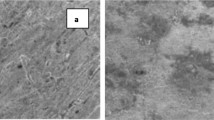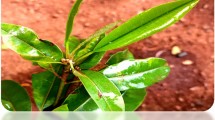Abstract
The corrosion inhibition evaluation of aluminium alloy AA7075-T7351 in 1.0 M HCl environment, by biologically active and water soluble luteolin 7—glucoside and phenolic polymeric compounds in Newbouldia laevis (NBL) extracts—as organic corrosion inhibitors of aluminium—have been investigated using gravimetric, electrochemical and thermodynamic techniques respectively, at room temperature (25 ± 1 °C), and at elevated temperatures of 40, 50, 60 and 65 °C. Gravimetric results showed that optimal inhibition efficiency (\(\zeta\)), at room temperature (298 ± 1 K) and 338 K are 86.1% and 67.5% respectively for the maximum concentration of 0.6 g/L. This suggests that NBL extract was affected by temperature and accomplished the inhibiting episode through an electrostatic pull of the polymeric components of the NBL extract onto AA7075-T7351 coupons or physical adsorption, that obeyed Langmuir, Freundlich and Temkin adsorption isotherms, in increasing order; Temkin, Freundlich and Langmuir. Adsorption coefficient, \(K_{\text{ads}}\), and Gibb’s free energy of adsorption, \(\Delta {\text{G}}_{\text{ads}}^{0}\), values obtained from Temkin isotherms were high and proved that adsorption of NBL on AA7075-T7351 surfaces were strong and spontaneous. Potentiodynamic polarization and electrochemical impedance spectroscopy results showed that NBL is a mixed-type corrosion inhibitor of AA7075-T7351 in 1 M HCl environment, which was achieved through the blockage/obstruction/reduction of charge flow by the polymeric barrier on the aluminium alloy’s surface. Increases in the linear part of the Bode plot slopes with increase in NBL concentrations further indicated the existence of a protective layer on the AA7075-T7351 surface.












Similar content being viewed by others
References
Gupta NK, Quraishi MA, Singh P, Srivastava V, Srivastava K, Verma C, Mukherjee AK (2017) Curcumine Longa: green and sustainable corrosion inhibitor for aluminium in HCl medium. Anal Bioanal Electrochem 9(2):245–265
Koch G (2017) Cost of corrosion. In: El-Sherik AM (ed) Trends in oil and gas corrosion research and technologies. Woodhead Publishing, Elsevier, Kidlington, pp 3–30
Umoren SA, Eduok UM, Solomon MM, Udoh AP (2016) Corrosion inhibition by leaves and stem extracts of Sida acuta for mild steel in 1 M H2SO4 solutions investigated by chemical and spectroscopic techniques. Arab J Chem 9:S209–S224
Goyal M, Kumar S, Bahadur I, Verma C, Ebenso EE (2018) Organic corrosion inhibitors for industrial cleaning of ferrous and non-ferrous metals in acidic solutions: a review. J Mol Liq 256:563–573
Reda S, Hameed A (2018) Cationic surfactant-Zn2+ systems as mixed corrosion inhibitors for carbon steel in a sodium chloride corrosive medium. Port Electrochim Acta 36(4):271–283
Ganash AA, Obaid AY, Elroby SAK, Hermas AA (2016) Corrosion inhibition of aluminum by using synthesized dipyridinium salts. Int J Electrochem Sci 11:5564–5579
Nazeer AA, Madkour M (2018) Potential use of smart coatings for corrosion protection of metals and alloys: a review. J Mol Liq 253:11–22
Ahmadi Y, Ahmad S (2019) Surface-active antimicrobial and anticorrosive oleo-polyurethane/graphene oxide nanocomposite coatings: synergistic effects of in-situ polymerization and π-π interaction. Prog Org Coat 127:168–180
Liu Y, Sun Q, Li W, Adair KR, Li J, Sun X (2017) A comprehensive review on recent progress in aluminum—air batteries. Green Energy Environ 2:246–277
Pratikno H, Titah HS (2017) Bio-corrosion on aluminium 6063 by Escherichia coli, in Marine environment. IPTEK J Technol Sci 28(2):55–58
Talbot DEJ, Talbot JDR (2018) Corrosion science and technology. CRC Press, Boca Raton, p 23
Hemanth J (2009) Quartz (SiO2p) reinforced chilled metal matrix composite (CMMC) for automotive applications. Mater Des 30(2):323–329
Sijo MT, Jayadevan KR (2016) Analysis of stir cast aluminium silicon carbide metal matrix composite: a comprehensive review. Int Conf Emerg Trends Eng Sci Technol Procedia Technol 24:379–385
Baradeswaran A, Elaya PA (2014) Study on mechanical and wear properties of 7075/Al2O3/graphite hybrid composites. Compos Part B 56:464–471
Nwosu FO, Owate IO, Osarolube E (2018) Acidic corrosion inhibition mechanism of aluminum alloy using green inhibitors. Am J Mater Sci 8:45–50
Andreatta F, Terryn H, de Wit JHW (2003) Corrosion behaviour of different tempers of AA7075 aluminium alloy. Electrochim Acta 49(17–18):2851–2862. https://doi.org/10.1016/j.electacta.2004.01.046
Zheng X, Gong M, Li Q, Guo L (2016) Corrosion inhibition of mild steel in sulfuric acid solution by loquat (Eriobotrya japonica Lindl.) leaves extract. Sci Rep 8:9140. https://doi.org/10.1038/s41598-018-27257-9
Muthukrishnan P, Prakash P, Jeyaprabha B, Shankar K (2015) Stigmasterol extract from Ficushispida leaves as a green inhibitor for the mild steeel corrosion in 1 M HCl solution. Arab J Chem. https://doi.org/10.1016/j.arabjc.2015.09.005
Arnott DR, Hinton BRW, Ryan NE (1989) Cationic- film-forming inhibitors for the protection of the AA7075 aluminium alloy against corrosion in aqueous chloride solution. Corrosion 45(1):12–18
Winkler DA, Breedon M, Hughes AE, Burden FR, Barnard AS, Harvey TG, Cole I (2014) Towards chromate-free corrosion inhibitors: structure-property models for organic alternatives. Green Chem 16(6):3349–3357
Harvey TG, Hardin SG, Hughes AE, Muster TH, Corrigan PA, Mardel J, Garcia SJ, Mol JMC, Glenn AM (2011) The effect of inhibitor structure on the corrosion of AA2024 and AA7075. Corros Sci 53(6):2184–2190
Channouf RB, Souissi N, Zanna S, Ardelean H, Bellakhal N, Marcus P (2018) Surface characterization of the corrosion product layer formed on the synthetic bronze in aqueous chloride solution and the effect of the adding of juniperus communis extract by X-ray photoelectron spectroscopy analysis. Chem Afr 1(3–4):167–174
Ansari KR, Quraishi MA, Singh A (2015) Isatin derivatives as a non-toxic corrosion inhibitor for mild steel in 20% H2SO4. Corros Sci 95:62–70
Saji VS (2010) A review on recent patent in corrosion inhibitors. Recent Pat Corros Sci 2:6–12
Verma C, Quraishi MA, Ebenso EE, Obot IB, El Assyry A (2016) 3-Amino alkylated indoles as corrosion inhibitors for mild steel in 1 M HCl: experimental and theoretical studies. J Mol Liq 219:647–660
Sharma YC, Sharma S (2016) Corrosion of aluminum by Psidium Guajava seeds in HCl solution. Port Electrochim Acta 34(6):365–382
Nnanna LA, Uchendu KO, Ikwuagwu G, John WO, Ihekoronye U (2016) Inhibition of corrosion of aluminum alloy AA8011 in alkaline medium using Palisota hirsute extract. Int Lett Chem Phys Astron 67:14–20
Chafki L, Rifi EH, Touir R, Touhami ME, Hatim Z (2018) Corrosion inhibition of mild steel in 1 M HCl solution by anhydrous tricalcium phosphate. Open Mater Sci J 12:69–81
Raghavendra N, Bhat JI (2016) Natural products for material protection: an interesting and efficacious anticorrosive property of dry arecanut seed extract at electrode (aluminum)–electrolyte (hydrochloric acid) interface. J Biol Tribol Corros. 2:21
Ennouri A, Lamiri A, Essahli M (2017) Corrosion inhibition of aluminium in acidic media by different extracts of Trigonellafoenum-graecum L. seeds. Port Electrochim Acta 35(5):279–295
Abd-El-Naby BA, Abdullatef OA, El-Kshlan HM, Khamis E, Abd-El-Fatah MA (2015) Effect of alkaline etching on the inhibition of the acidic corrosion of aluminum by lupine extract. Port Electrochim Acta 33(1):1–11
Nnanna LA, Obasi VU, Nwadiuko OC, Mejeh KI, Ekekwe ND, Udensi SC (2012) Inhibition by Newbouldia laevis leaf extract of the corrosion of aluminium in HCl and H2SO4 solutions. Arch Appl Sci Res 4(1):207–217
Ejikeme PM, Umana SG, Onukwuli OD (2012) Corrosion inhibition of aluminium by Treculia Africana leaves extract in acid medium. Port Electrochim Acta 30(5):317–328. https://doi.org/10.4152/pea.201205317
Harbone BJ (1998) Phytochemical methods—a guide to modern techniques of plant analysis. Chapman and Hall, London. https://doi.org/10.1007/978-94-009-5570-7
Standard practice for preparing, cleaning, and evaluating corrosion test specimens, ASTM G1-03 2003 standard
Standard practice for Laboratory immersion corrosion testing of metals, ASTM G31-72 (re-approved 2004)
Okoro CC, Samuel O, Lin J (2016) The effects of Tetrakis-hydroxymethyl phosphonium sulfate (THPS), nitrite and sodium chloride on methanogenesis and corrosion rates by methanogen populations of corroded pipelines. Corros Sci 112:507–516
Manimegalai S, Manjula P (2015) Thermodynamic and adsorption studies for corrosion inhibition of mild steel in aqueous media by Sargasam swartzii (Brown algae). J Mater Environ Sci 6(6):1629–1637
Nwanonenyi SC, Obasi HC, Chukwujike IC, Chidiebere MA, Oguzie EE (2019) Inhibition of carbon steel corrosion in 1 M H2SO4 using soy polymer and polyvinylpyrrolidone. Chem Afr 2(2):277–289
Verma C, Olasunkanmi LO, Ebenso EE, Quraishi MA, Obot IB (2016) Adsorption behavior of glucosamine-based, pyrimidine-fused heterocycles as green corrosion inhibitors for mild steel: experimental and theoretical studies. J Phys Chem C 120:11598–11611
Muthukrishnan P, Jeyaprabha B, Prakash P (2017) Adsorption and corrosion inhibiting behaviour of Lannea coromandelica leaf extract on mild steel corrosion. Arab J Chem 10:S2343–S2354
Shivakumar SS, Mohana KN (2013) Studies on the inhibitive performance of Cinnamomum zeylanicum extracts on the corrosion of mild steel in hydrochloric acid and sulphuric acid media. J Mater Environ Sci 4(3):448–459
Iroha NB, Nnanna LA (2019) Electrochemical and adsorption study of the anticorrosion behavior of Cefepime on pipeline steel surface in acidic solution. J Mater Environ Sci 10(10):898–908
Nnanna LA, Nwadiuko OC, Ekekwe ND, Ukpabi CF, Udensi SC, Okeoma KB, Onwuagba BN, Mejeha IM (2011) Adsorption and inhibitive properties of leaf extract of Newbouldia leavis as a green inhibitor for aluminium alloy in H2SO4. Am J Mater Sci 1(2):143–148. https://doi.org/10.5923/j.materials.20110102.24
Sharma SK, Peter A, Obot IB (2015) Potential of Azadirachta indica as a green corrosion inhibitor against mild steel, aluminum, and tin: a review. J Anal Sci Technol 6(1):26
Hassan KH, Khadom AA, Kurshed NH (2016) Citrus aurantium leaves extracts as a sustainable corrosion inhibitor of mild steel in sulfuric acid. S Afr J Chem Eng 22:1–5
Ituen E, Akaranta O, James A (2017) Evaluation of performance of corrosion inhibitors using adsorption isotherm models: an overview. Chem Sci Int J 18(1):1–34
Raghavendra N (2020) Green Compounds to attenuate aluminum corrosion in HCl activation: a necessity review. Chem Afr 3:21–34
Verma C, Olasunkanmi LO, Ebenso EE, Quraishi MA (2018) Adsorption characteristics of green 5-arylaminomethylene pyrimidine-2,4,6-triones on mild steel surface in acidic medium: experimental and computational approach. Res Phys 8:657–670
Nnanna LA (2015) Electrochemical study of corrosion inhibition of mild steel in acidic solution using Gnetum Africana leaves extracts. Br J Appl Sci Technol 5(6):556–567
Solmaz R (2014) Investigation of corrosion inhibition mechanism and stability of Vitamin B1 on mild steel in 0.5 M HCl solution. Corros Sci 81:75–84
Elkhotfi Y, Forsal I, Rakib EM, Mernari B (2018) The inhibition action of essential oil of J. Juniperus Phoenicea on the corrosion of of mild steel in acidic media. Port Electrochim Acta 36(2):77–87
Udensi SC, Ekpe OE, Nnanna LA (2019) Electrochemical, gravimetric and thermodynamic studies of corrosion inhibitive performance of Treculia africana on AA7075-T7351 in 1.0 M HCl. J Mater Environ Sci 10(12):1272–1295
Haddadi SA, Alibakhshi E, Bahlakeh G, Ramezanzadeh B, Mahdavian M (2019) A detailed atomic level computational and electrochemical exploration of the Juglans regia green fruit shell extract as a sustainable and highly efficient green corrosion inhibitor for mild steel in 3.5 wt% NaCl solution. J Mol Liq 284:682–699
Alibakhshi E, Ghasemi E, Mahdavian M (2013) Corrosion inhibition by lithium zinc phosphate pigment. Corros Sci 77(2013):222–229. https://doi.org/10.1016/j.corsci.2013.08.005
Alibakhshi E, Ramezanzadeh M, Haddadi SA, Bahlakeh G, Ramezanzadeh B, Mahdavian M (2019) Persian Liquorice extract as a highly efficient sustainable corrosion inhibitor for mild steel in sodium chloride solution. J Clean Prod 210:660–672
Dehghani A, Bahlakeh G, Ramezanzadeh B (2019) A detailed electrochemical/theoretical exploration of the aqueous Chinese gooseberry fruit shell extract as a green and cheap corrosion inhibitor for mild steel in acidic solution. J Mol Liq 282:366–384
Aljourani J, Raeissi K, Golozar MA (2009) Benzimidazole and its derivatives as corrosion inhibitors for mild steel in 1 M HCl solution. Corros Sci 51:1836–1843
Mahdavian M, Ashhari S (2010) Corrosion inhibition performance of 2-mercaptobenzimidazole and 2-mercaptobenzoxazole compounds for protection of mild steel in hydrochloric acid solution. Electrochim Acta 55:1720–1724. https://doi.org/10.1016/j.electacta.2009.10.055
Bentiss F, Traisnel M, Lagrenee M (2000) The substituted 1, 3, 4-oxadiazoles: a new class of corrosion inhibitors of mild steel in acidic media. Corros Sci 42:127–146
Frignani A, Tommesani L, Brunoro G, Monticelli C, Fogagnolo M (1999) Influence of the alkyl chain on the protective effects of 1,2,3-benzotriazole towards copper corrosion. Part I: inhibition of the anodic and cathodic reactions. Corros Sci 41:1205–1215
Author information
Authors and Affiliations
Corresponding author
Rights and permissions
About this article
Cite this article
Udensi, S.C., Ekpe, O.E. & Nnanna, L.A. Newbouldia laevis Leaves Extract as Tenable Eco-Friendly Corrosion Inhibitor for Aluminium Alloy AA7075-T7351 in 1 M HCl Corrosive Environment: Gravimetric, Electrochemical and Thermodynamic Studies. Chemistry Africa 3, 303–316 (2020). https://doi.org/10.1007/s42250-020-00131-w
Received:
Accepted:
Published:
Issue Date:
DOI: https://doi.org/10.1007/s42250-020-00131-w




